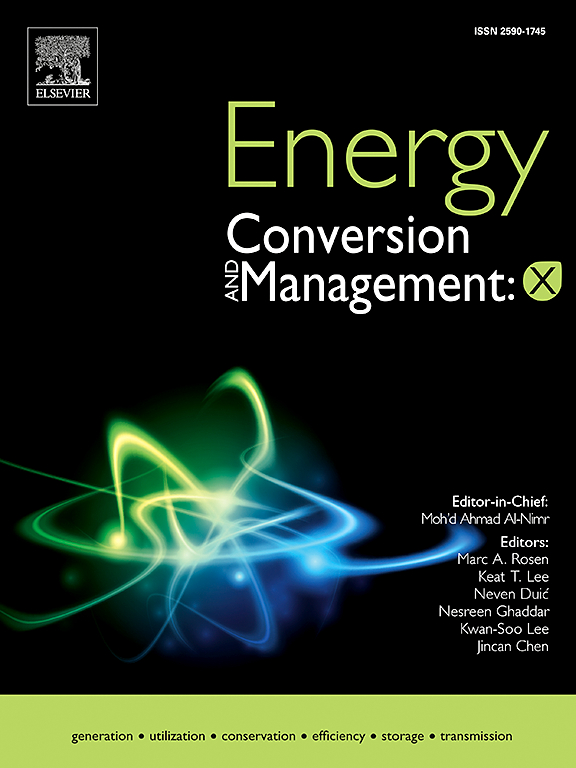电池存储的环境套利:减少发电过程中的排放
IF 7.6
Q1 ENERGY & FUELS
引用次数: 0
摘要
尽管近年来电力行业的排放量显著减少,但社会对环境的担忧仍在继续。同样,储能系统所经历和预期的技术和经济进步也使其成为电力系统运行的又一工具。这项工作开发了一个模型,该模型使用公用事业规模的能源电池,打算在批发电力市场上进行环境套利,包括在边际技术无污染的时间购买能源,并在具有高污染边际技术的时间出售能源。为了解决这一社会套利问题,提出了一种混合整数线性规划模型。由于问题取决于电池和逆变器尺寸之间的比例,在不失去通用性的前提下,考虑到电池因充放电周期而退化,规划周期为25年,通过参数化将逆变器尺寸固定在1到8 MW,求解了10MWh电池的模型。对于每个逆变器,优化模型提供了避免排放的最优策略。最后,通过在每年的正现金流中包含社会从当年避免的每吨二氧化碳排放中获得的隐含价值来计算每种投资选择的净现值。我们的研究结果表明,考虑到当前排放配额的价格,这种类型的投资是社会可取的。10兆瓦时/6兆瓦的速度在环境方面提供了最有希望的结果。纯经济套利破坏净值,2mw逆变器破坏的净值最小。本文章由计算机程序翻译,如有差异,请以英文原文为准。
Environmental arbitrage with battery storage: Reducing emissions from electricity generation
Although the power industry has significantly reduced its emissions in recent years, society’s environmental concerns continue. Likewise, the technological and economic progress experienced and expected in energy storage systems has allowed them to be incorporated as one more tool for electricity system operations. This work develops a model that, using utility-scale energy batteries, intends to carry out an environmental arbitrage in the wholesale electricity market consisting of buying energy in those hours in which the marginal technology is non-polluting and selling it in those hours with highly polluting marginal technologies. To solve this social arbitrage problem, a mixed-integer linear programming model has been proposed. Since the problem depends on the ratio between battery and inverter sizes, without losing generality, the model is solved for a battery of 10MWh by parametrically fixing the inverter size from 1 to 8 MW, considering the battery degradation due to charge/discharge cycles and a planning horizon of 25 years. For each inverter, the optimization model provides the optimal strategy to avoid emissions. Finally, the net present value of each investment alternative is calculated by including in the positive cash-flow of each year the implicit value that society obtains from each ton of CO2 emissions avoided in that year. Our results suggest that this type of investment is socially desirable, given the current prices of emission allowances. The rate of 10 MWh/6 MW offers the most promising results in environmental temrs. Purely economic arbitrage destroys net value, with the 2 MW inverter destroying the least value.
求助全文
通过发布文献求助,成功后即可免费获取论文全文。
去求助
来源期刊

Energy Conversion and Management-X
Multiple-
CiteScore
8.80
自引率
3.20%
发文量
180
审稿时长
58 days
期刊介绍:
Energy Conversion and Management: X is the open access extension of the reputable journal Energy Conversion and Management, serving as a platform for interdisciplinary research on a wide array of critical energy subjects. The journal is dedicated to publishing original contributions and in-depth technical review articles that present groundbreaking research on topics spanning energy generation, utilization, conversion, storage, transmission, conservation, management, and sustainability.
The scope of Energy Conversion and Management: X encompasses various forms of energy, including mechanical, thermal, nuclear, chemical, electromagnetic, magnetic, and electric energy. It addresses all known energy resources, highlighting both conventional sources like fossil fuels and nuclear power, as well as renewable resources such as solar, biomass, hydro, wind, geothermal, and ocean energy.
 求助内容:
求助内容: 应助结果提醒方式:
应助结果提醒方式:


